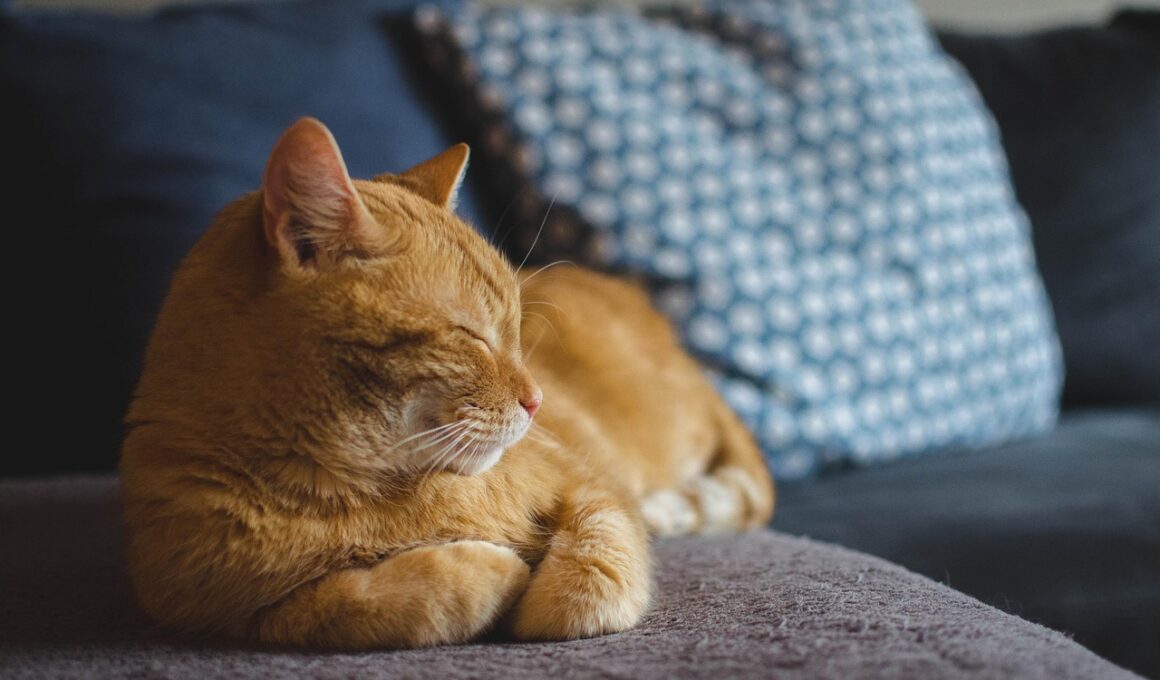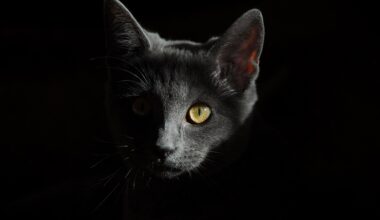Understanding the Myth of Cats’ Nighttime Hyperactivity and Mental Health
Many pet owners often notice their cats being hyperactive at night. This behavior is commonly misinterpreted as a sign of underlying mental health issues. However, in reality, the nocturnal nature of cats is a far more reasonable explanation. Cats are crepuscular creatures, meaning they are most active at dawn and dusk. This behavior is inherited from their wild ancestors who hunted during these twilight hours. Pet owners who observe their cats racing around the house at night might be concerned about potential anxiety or stress. Yet, hyperactivity does not necessarily translate to mental distress in felines. Educating oneself about a cat’s natural instincts significantly helps in understanding their behavior. Additionally, establishing a regular playtime routine can significantly help to channel this energy positively. Providing toys, scratching posts, and climbing structures encourages safe exploration and activity. Owners should recognize that this nighttime hyperactivity is just part of a cat’s innate behavior rather than an indication of poor mental health. Misinterpretations can lead to unnecessary stress for both the cat and the owner, promoting helpful interventions may help mitigate concern and highlight understanding.
Cats’ nighttime hyperactivity can also be related to their natural instincts as hunters. These instincts prompt them to be most active when their prey is available. Owners need to remember that their cats share a lineage with wild felines. Outdoor hunting behaviors were essential for survival. This nocturnal activity is not inherently negative; rather, it is a fundamental aspect of their personality. Moreover, creating an environment that stimulates their instincts can transform these nighttime escapades into positive experiences. Providing interactive toys, puzzle feeders, and even laser pointers can engage your cat’s mind and keep them busy during evening hours. This engagement not only entertains them but also helps to tire them out adequately. Throughout the day, owners should ensure that their cats receive ample attention through playtime to help manage their energy levels. An enriched environment goes a long way in promoting mental well-being for cats. Owners can utilize vertical spaces such as shelves to allow cats to explore and engage with their environment creatively. This way, they can satisfy their natural instincts, which helps to ensure a balanced mental state for their beloved pets.
The Role of Mental Stimulation in Feline Health
Mental stimulation plays a crucial role in a cat’s overall well-being and can help alleviate hyperactive behaviors. Cats are intelligent animals that require mental challenges to maintain their happiness and health. Without sufficient stimulation, cats might exhibit behavioral problems unrelated to their mental health status. Providing puzzle toys, engaging activities, and playtime can significantly enrich a cat’s life. Owners should consider varying their cat’s routine to keep things interesting for them. For example, rotating toys regularly helps to maintain a cat’s interest. Additionally, consider setting aside time each week for interactive play sessions. These sessions allow owners to bond with their cats and provide an outlet for their natural energy. Engaging cat trees encourage physical activity and serve as excellent tools for cognitive stimulation. Importantly, mental health myths surrounding feline nighttime hyperactivity often overlook the essential aspects of a cat’s upbringing. By focusing on providing enriching environments that cater to their instincts, owners can foster healthy behaviors. This understanding can change the way owners perceive their cat’s activities, alleviating unnecessary worry regarding hyperactivity at night and clarifying mental health misconceptions.
Understanding feline body language can help pet owners discern whether their cat’s nighttime activities are playful or indicative of anxiety. Stress-related behaviors, such as excessive grooming or hiding, often require different approaches than observing high energy. By distinguishing various behaviors, owners can directly address their pet’s needs without crossing into panic mode. For example, if your cat is simply playing with toys and having fun, there likely is no need for concern. Consider also that natural sleep cycles differ for cats than humans; we may not realize that nighttime antics are perfectly normal. Owners should also consult with veterinarians if they suspect behavioral issues stemming from anxiety rather than hyperactivity. Professional guidance can clarify discernible signs of distress and illuminate productive solutions for addressing potential issues. Moreover, spending time socializing and bonding with your cat can relieve worry and create a sense of security. This connection fosters confidence, consequently alleviating signs of anxiety effectively. Furthermore, using calming aids, such as pheromone diffusers, can help calm overly active nighttime behaviors while promoting relaxation when needed. Understanding these differences ensures a more harmonious coexistence between owners and their feline friends.
Creating a Calm Environment for Your Cat
Creating a calm and soothing environment is essential in addressing nighttime hyperactivity in cats. Sensory elements in your home greatly influence cats’ behavior. Bright lights and loud noises can induce anxiety and encourage nighttime restlessness. Provide your cats with safe, cozy spaces where they feel secure. Creating a designated sleeping area with comfortable bedding can help foster consistent sleep habits. Soft, dim indoor lighting can also help adjust their natural rhythms while promoting relaxation. Furthermore, consider implementing a consistent routine for feeding and playtime. Animals thrive on predictability and routine, and a familiar schedule can alleviate stress, leading to a reduction in hyperactive behaviors at night. Calming music or sounds can have a soothing effect, particularly during their less active hours. Opt for soft classical music or nature sounds to offer serenity during the evening. Implementing these home adjustments ensures your cat’s night environment is conducive to relaxation. Making a few simple changes can help modify your cat’s behavior, ensuring necessary rest periods, resulting in significantly lower instances of dreaded nighttime activities. With patience, you can create a genuinely peaceful atmosphere that caters to their needs.
Regular veterinary check-ups play an important role in monitoring your cat’s health, ensuring they receive necessary vaccinations and early detection of any health issues. Some underlying medical conditions can manifest as behavioral changes, so it is crucial to keep up with routine healthcare. Owners should not underestimate the importance of comprehensive wellness exams, as veterinarians can provide valuable insights into behavioral problems. Moreover, experts can guide diet changes, nutritional needs, and other factors that contribute to overall well-being. Adequate nutrition is vital for energy levels, helping to stabilize activity patterns. A balanced diet tailored to your cat’s age and activity can have long-term benefits for mental and physical health. Identifying food sensitivities or allergies can also lead to behavioral changes affecting hyperactivity. An open dialogue with your veterinarian can improve health management, as they can determine if your cat’s activities are natural, or symptoms indicating deeper concerns. Enabling a healthy lifestyle through regular interaction creates a fulfilling environment for cats. With proper guidance, owners can offset common behavioral issues, recognizing the essential link between health and mental well-being in cats, clarifying many misconceptions surrounding their nighttime behaviors.
Conclusion: Embracing Your Cat’s Nature
In conclusion, understanding the myth surrounding your cat’s nighttime hyperactivity is essential in regard to their mental health. Recognizing that these behaviors stem from their innate instincts can change your perspective significantly. By combining proper engagement, environmental considerations, and comprehensive healthcare, you can create a nurturing space for your feline companion. Myths surrounding mental health in cats often lead to unnecessary panic and anxiety for both pets and owners alike. Fostering a unique understanding of these natural instincts is pivotal in nurturing overall well-being. Establishing a structured routine that encompasses play, social interaction, and plenty of stimulation allows for a more satisfying life for your cat while alleviating unnecessary stress for both. Focusing on effective strategies helps you embrace their lively nature and provides insight into their most common behaviors. An enriched environment allows your cat to thrive emotionally and physically, reinforcing the bond you share. With respectful understanding, cat owners can appreciate the delightful quirkiness of their cats while promoting a harmonious household. Ultimately, embracing their nature leads to a fulfilled, contented cat and a happier shared life.
Taking all of these factors into consideration demonstrates that our understanding of cats should evolve based on knowledge, observation, and compassion. A clear distinction between hyperactivity as a natural behavior and signs of stress or anxiety cultivates a more trusting relationship between cats and their owners. By implementing strategies to accommodate their nocturnal tendencies and understanding mental health isn’t synonymous with hyperactive behavior, we can appreciate our pets better. Each cat has its personality, and they all require tailored care to help navigate their unique needs. This journey into the realm of feline mental health should be empowering for both pets and owners, leading to lasting joy. Providing a safe, enriching, and loving environment fosters not only their playful spirit but their well-being overall. As we take heed of their behavior, creating conducive spaces ensures that owners and cats need not face the nighttime misunderstandings together. As knowledgeable caretakers, we have the power to transform our homes into enriching environments that champion their mental health. Understanding their world brings us closer together, allowing us to celebrate their unique qualities as beloved companions.


